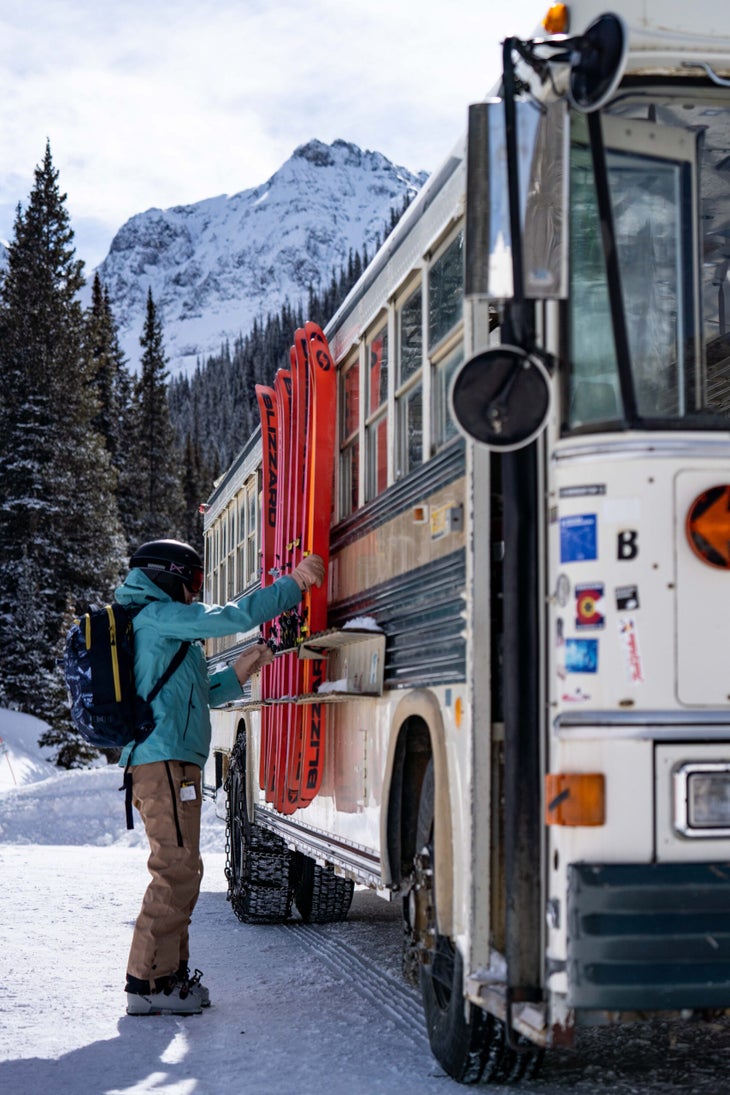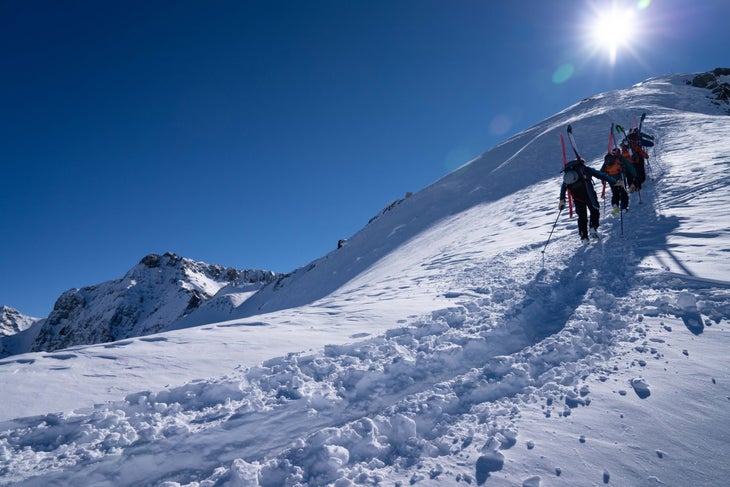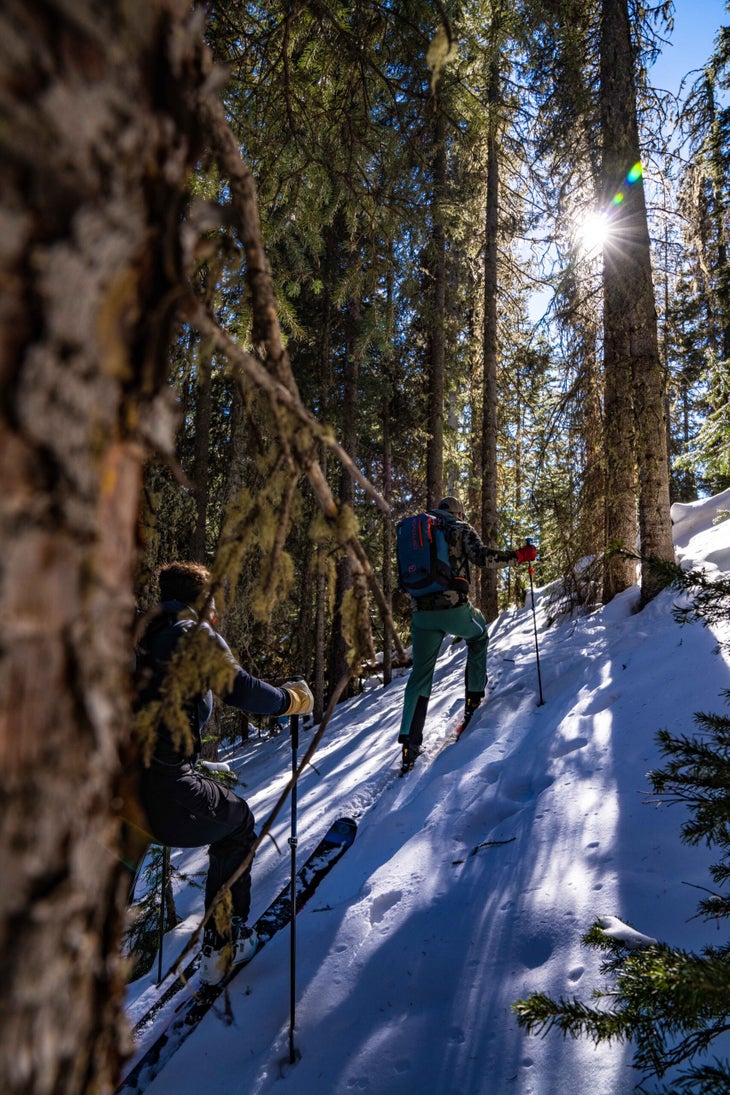Products You May Like
I do not usually ski this way in the backcountry, but right now, I’m letting it all hang out at a pace that has my hormones bubbling. The remains of old avalanches streak past to my left and right as I race down a ribbon of untouched powder with old chunks of cornice to dodge. Charging through variable terrain beyond the ropes can feel reckless, but when your skis are this solid, you can’t help opening it up a bit.
But I might not feel so burnt if I wasn’t testing Blizzard’s new Hustle 11 ski, along with a fresh set of ATK Freeraider 16-pin bindings. To put it plainly, this particular combo of hybrid backcountry gear—along with my uber-stiff Dynafit Hoji Free 130 boots—makes me feel like I’m shredding my home resort on full alpine equipment. (I am, in fact, in the Colorado backcountry, in the unfamiliar San Juan Mountains, 1,000 miles from my home.)

I come to a feverish halt at the end of the run and rejoin my group in a frenetic buzz. I’m immediately ready for more because it didn’t cost me 3,000 calories to get these skis to the top of the run, nor down it. They’re light, but not enough to deflect, and just stiff enough to be stable while being supple enough to save me having to muscle them down the mountain. This feels new, though it’s been a long time coming.
In years past, getting this much support from a ski would have come with a weight penalty, but no longer. That’s because the evolving category of “crossover” gear that’s been clumsily emerging for so long (remember the Marker Duke and Salomon Guardian?) has finally gotten good.
Snowsports Industries America has been reporting for years that backcountry skiing is the fastest growing segment of the ski industry, and the pandemic only made that more pronounced. But it’s taken mainstream ski manufacturers a while to fully tune into that dynamic. For the longest time, the biggest ski companies didn’t offer much when it came to backcountry skis, and when they did, they kept them skinny and light for the purist crowd. If you likewise wanted anything less than brick for a touring binding, you had to go for pin bindings (which continue to not be a good choice inbounds, FYI).

Meanwhile, there was nuance being missed: Most backcountry users are hybrid skiers, and they’re still mixing in a lot of resort skiing. At the very least, most are looking for the familiar feeling of their resort gear when they ski out of bounds. There’s a whole galaxy between being a rando racer and a freerider, and it took the big brands too long to understand this. But as it turns out, that middle ground is a big market slice. There’s probably no better testament to this than the success of Salomon’s Shift binding (also branded by Armada and Atomic), which is on its way to becoming the most ubiquitous set of clamps at North American resorts. (The Shift is a reasonably lightweight hybrid touring binding that lets you climb with pins but ski locked into an alpine binding.)
Bindings have always been ahead of the curve, though, since they need to be specific (boots too, but that’s a whole other topic). Skis have taken a while to catch up to the crossover idea because any ski that works inbounds works in the backcountry, too, so why design specifically for that? The answer, in short, is weight and flex, and because people want it.
Blizzard saw the light this season when it announced a full new family of touring skis called the Hustle. The company took shapes from its beloved Rustler lineup, re-tuned the flex patterns for powder, lightened them up, and found itself sitting at the cool kids’ table suddenly. Where previously the widest dedicated backcountry ski Blizzard offered was 105 underfoot, now it has a whole series of freeride touring shapes available up to 114. That represents a woke acknowledgment that freerides and touring not only can happen together—they should.

“Our choice to move into the hybrid backcountry (crossover) market was a logical step for us,” explains Jed Duke, global product director at Blizzard Tecnica. “We could see the crossover trend coming through our athletes … we’ve seen a shift in the market that basically follows the powder. Alpine skiers who want to access softer snow, in general, are venturing more into the backcountry to find it. These customers are looking for gear that will deliver great downhill performance—so they don’t have to sacrifice anything on the down—but is lighter weight so they can access more terrain in an easier way.”
For 2023, Nordica also followed that trend and revamped its Enforcer lineup into its new Unlimited series. It too wanted to offer something with more meat than traditional touring skis, says North American Marketing Director Sam Beck.
“Skis that prioritize a lightweight build have a tendency to be sketchy and unstable on the way down. You can see it from a mile away when someone is in this uncomfortable situation, trying to make their way down like a cat holding on for dear life. The Unlimited [series] goal was to build lightweight versions of our award-winning all-mountain Enforcer and Santa Ana shapes that improve the uphill experience. Whether in-bounds or out, people want to be able to go for a skin lap and then hit the resort without having to swap out their skis. Or if the resort is not part of the adventure, the confidence is all there for the down.”
So while some brands are still segregating ski-tourers from the general population, the market is throwing bones to those companies that can feel the future. Finally, we backcountry half-breeds are being seen.
See how the Hustle stacks up against other skis in this category when we release the 2023 Gear Guide later this month.
